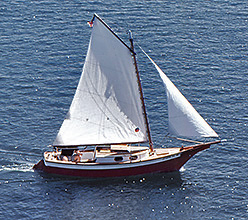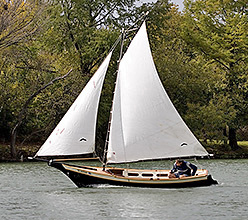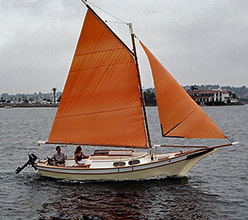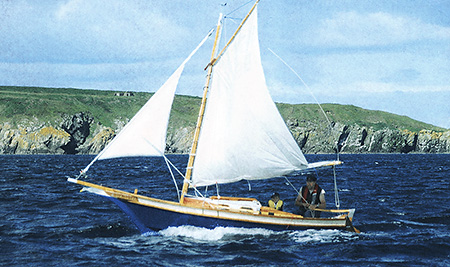

![]()
All of our sailboats are UNBALLASTED and designed for sailing in Protected Waters...That said, Are they safe boats? We think they are, and many years ago the Canadian Coast Guard did an analysis and decided they were fine little boats (and NO, we don't have a copy of that document or letter, sadly! One of the vagaries of having been in business for over Half A Century now: We've lost stuff alng the way...)
So why do they take the weather so well? Well, if you look at the shape of the Weekender (and Vacationer and Skipjack, too) it's nothing more than a dory with the rear sliced off into a transom and a keelson scabbed on. And if you’ve ever seen “Captains Courageous” you know how well dories take the rough stuff!
Obviously, one shouldn't try to go out in heavier conditions than one is comfortable with, but if you do end up out in a bit more weather than you'd like, you can be happy that the clipper-bow-shaped hull can deal with a lot. We usually agree with Capt. Eddie Rickenbacker's opinion that anything that moves can be dangerous; this is certainly true for boats, ours included, but over the years so many of our builders have written us with stories of how they've enjoyed their boats in good and bad weather that we feel a bit of justifiable designer's-pride.
As to just what sort of sea-state these boats can handle, it depends a lot on the builder-skipper. We'd recommend wrapping things up and heading for a cozy chair and a nice book if you know it's going to be blowing 25kts, as I think anyone would. A fine, breezy day of 15-20kts can be great fun if you know what you're doing, and it can be far less fun if you're not prepared for it. Start slowly and build up confidence and experience and above all, Have Fun!
We have sailed our boats in conditions we REALLY shouldn't have been out in...But we know our boats REALLY well. Peter and I took the Kauai Weekender out of Hanalei Bay on a gorgeous day in 1986, with the Tradewinds blowing hard enough to whistle in the rigging, and far enough out to be in the BIG open swells of 15'-20' — Big enough to lose sight of everything in the trough and be sailing up, up, up, then WOW, downand watch we don't round up! No radio, before cell phones — basically no safety gear at all, as we just got caught up in the moment and headed out to sea. Wewere LUCKY and we were CAREFUL. But DON'T do as we did, Do as You Ought To Do.
Still: Those are memories I'll always treasure.
I took the Super Skipjack up to Tomales Bay for a sail and it turned out to be POURING rain and foggy (but nice enough when I got there to decide to launch and head out!) Once again: No radio or cellphone. I did have lifejackets and weather gear, so I wasn't entirely stupid, but I did have to learn how to reef while headed into the wind and in the middle of the bay (turns out the Skipjack sits happily while you work like a crazed man at the base of the mast!) And then I had a GREAT sail! Watch the video here!
And that practice made me confident enough to sail that Skipjack out of Stillwater Cove in Pebble Beach, and I had to reef underway again! (I guess that's why they call it STILLwater Cove: Still in there, but screaming around the point!) And that video is here to watch, too!
So you get the idea: BE CAREFUL (more than we were in past decades), and Learn Your Limits. ANYTHING can be dangerous, and almost anything can be managed, if you know what you're doing. So KNOW What YouDon't Know, and What You Want To Know!
Now: On to the testimonials!
So why do they take the weather so well? Well, if you look at the shape of the Weekender (and Vacationer and Skipjack, too) it's nothing more than a dory with the rear sliced off into a transom and a keelson scabbed on. And if you’ve ever seen “Captains Courageous” you know how well dories take the rough stuff!
Obviously, one shouldn't try to go out in heavier conditions than one is comfortable with, but if you do end up out in a bit more weather than you'd like, you can be happy that the clipper-bow-shaped hull can deal with a lot. We usually agree with Capt. Eddie Rickenbacker's opinion that anything that moves can be dangerous; this is certainly true for boats, ours included, but over the years so many of our builders have written us with stories of how they've enjoyed their boats in good and bad weather that we feel a bit of justifiable designer's-pride.
As to just what sort of sea-state these boats can handle, it depends a lot on the builder-skipper. We'd recommend wrapping things up and heading for a cozy chair and a nice book if you know it's going to be blowing 25kts, as I think anyone would. A fine, breezy day of 15-20kts can be great fun if you know what you're doing, and it can be far less fun if you're not prepared for it. Start slowly and build up confidence and experience and above all, Have Fun!
We have sailed our boats in conditions we REALLY shouldn't have been out in...But we know our boats REALLY well. Peter and I took the Kauai Weekender out of Hanalei Bay on a gorgeous day in 1986, with the Tradewinds blowing hard enough to whistle in the rigging, and far enough out to be in the BIG open swells of 15'-20' — Big enough to lose sight of everything in the trough and be sailing up, up, up, then WOW, downand watch we don't round up! No radio, before cell phones — basically no safety gear at all, as we just got caught up in the moment and headed out to sea. Wewere LUCKY and we were CAREFUL. But DON'T do as we did, Do as You Ought To Do.
Still: Those are memories I'll always treasure.
I took the Super Skipjack up to Tomales Bay for a sail and it turned out to be POURING rain and foggy (but nice enough when I got there to decide to launch and head out!) Once again: No radio or cellphone. I did have lifejackets and weather gear, so I wasn't entirely stupid, but I did have to learn how to reef while headed into the wind and in the middle of the bay (turns out the Skipjack sits happily while you work like a crazed man at the base of the mast!) And then I had a GREAT sail! Watch the video here!
And that practice made me confident enough to sail that Skipjack out of Stillwater Cove in Pebble Beach, and I had to reef underway again! (I guess that's why they call it STILLwater Cove: Still in there, but screaming around the point!) And that video is here to watch, too!
So you get the idea: BE CAREFUL (more than we were in past decades), and Learn Your Limits. ANYTHING can be dangerous, and almost anything can be managed, if you know what you're doing. So KNOW What YouDon't Know, and What You Want To Know!
Now: On to the testimonials!
Some of you may be wondering about the safety of these designs and about how they handle rough conditions. An understandable concern. We've sailed them in varying conditions over many, many years and know they work great.
Don’t take our word for it though: Here are some comments by both beginners and experts who have built our Pocket Yachts!
A Weekender skipper and his son off the coast of Scotland!
...”Wow, guys and gals what a nice day on the water. I sailed Couer d’Alene today and the wind was 25-35 mph with very rough water. What a blast! I know that much wind is about the most we should be sailing the Weekenders in but I have got to tell you these boats do just fine in a strong blow. I was single-handing and wore the pfd all the time, safety first, you know. I never had a close call and I both tacked and jibed, no problem. Stats for the day are...top speed 5.7 knots and 7.2km in about 2-1/2 hours. I know I have said it before, These boats are great!”
T. Nelson Surbrook
T. Nelson Surbrook
...“I didn’t know how to sail, but have been learning since completing my boat. It has to be the most forgiving sailboat ever designed. When I panic, I just let everything go and she comes right into the wind and stabilizes! Fantastic! Also have to tell you she’ an eye-catcher. I recently entered her in the prestigious Hessel Boat Show in Hessel MI and it was by far the most photographed boat at the show...
William P. Hankes
William P. Hankes
...”I had a great day sailing this past weekend as “O-Kee-Pa” hit the drink for the first time. It was pleasure to build, I earned a mess of stuff, and it sails excellent. I had along my 2 cousins, one who races Farr 40’s for a living, and the other who is captain of a 90’ sailboat in Seattle. Both of them were very satisfied with your design and it was a great site to see them sailing along the river in my boat with happy children aboard. Anyway, I enclosed a pic and just wanted to extend a thank you for a job well done.”
Eris Noren
Eris Noren
“...The weather was cold & overcast & calm. At first! Then it changed dramatically to windy and 2’ whitecaps (honestly)...Did I build it correctly? Will everything hold? The water was freezing cold & we’re out in the middle of the lake, and no other boats in sight.
She did fine and I was complimented {by a crew of experienced sailors} on how well she handled & was constructed.,,, Now I could trust the boat for my family!
William Bainter
She did fine and I was complimented {by a crew of experienced sailors} on how well she handled & was constructed.,,, Now I could trust the boat for my family!
William Bainter
...Out in the bay it gets worse. I’m certain the wind was better than 25 knots, and the 1-3 foot waves were coming in broadside when I was making course for Bristol Harbor. The rogue four or five foot wave would come every couple of minutes and I altered course to minimize chance of a capsize...I was on a screaming reach, and the boat was settling in her wave. I’m certain I was above hull speed, though my gps refused to lock onto any satellites for some reason, so I can’t be certain how fast I was going.
I got a temporary break from the wind when I passed the northern point entering Bristol Harbor and I turned on the weather radio, curious how they were going to explain away this “10 knots of wind”. They explained it with a Small Craft Advisory with winds 26-31 knots, gusting to 36 and 3-5 seas. A little late, I thought. But I did cross the three miles to Bristol Harbor in a little less than half an hour. Wow.
[At the ramp] A few folks looked at me oddly as I pulled out. I guess they aren’t used to seeing folks sailing a micro cruiser in forty degree November weather, and a brewing storm. Go figure.
Adam Plourde
I got a temporary break from the wind when I passed the northern point entering Bristol Harbor and I turned on the weather radio, curious how they were going to explain away this “10 knots of wind”. They explained it with a Small Craft Advisory with winds 26-31 knots, gusting to 36 and 3-5 seas. A little late, I thought. But I did cross the three miles to Bristol Harbor in a little less than half an hour. Wow.
[At the ramp] A few folks looked at me oddly as I pulled out. I guess they aren’t used to seeing folks sailing a micro cruiser in forty degree November weather, and a brewing storm. Go figure.
Adam Plourde
“...Sailing on the jib alone in big wind is just fine. Regardless of big blasts, if I only have the jib up, I can relax and just enjoy being under-powered...I love my boat!”
Konrad Broer
Konrad Broer
“...As I promised I’m sending shots of the launching day of “Aqualuna”. Everything worked better than I expected, she is very stable and sails great. Even though I did not purchase the plans from you (a friend of mine gave them to me) I wish to thank you for such a wonderful work. From now on, Stevenson Projects have a new enthusiast.”
John N. Bitar
John N. Bitar
...so we launched the boat and raised the sails while still tied to the dock. Angry gusts were snatching at the sails and I started to think twice, again. We shoved off anyway, which was exciting because the boat immediately accelerated away from the dock like it was being towed by a ski boat. I got Mike briefed on which side to sit on, and not to sit on any ropes, and we careened around in tight circles. The wind was from all directions at once in the channel. Mike asked when we going to stop goofing around and hit the "Big Water", which meant coming out of the lee of the island and into the big part. I said we'd poke our nose out a ways and see what it was like. Big waves were cruising by with white foamy tops and I wondered if this might not be another of my stupid ideas born of impatience and stubbornness. Anyway we blasted out into the big stuff going just about as fast as I've ever seen the boat go, the wake was foaming white on both ends of the boat and when we left the shelter of the island we slipped neatly into the swells and paralleled them. I turned the boat into the wind a bit to hit the swells on a 45 degree angle or so, and we climbed up one side, and just as she crested the top of a wave, when I was expecting a big slap, down went the bow and she just cleaved neatly through the top of the wave and slid down the back side. Soon we were approaching an island on the far side of the bay, and it was time to tack. By this time I had showed Mike how to trim the jib and put him in control of that sail. He had to pull the sheet with all his might to get the sail under control-for the first time I wondered if anyone has ever put sail winches on a weekender. She came around neatly, and Mike didn't need to be told to let the sheet fly and scramble across the boat to grab the other one and start hauling. The waves were big enough that we were slowing down in the troughs and catching big gusts at the crests, requiring some attention. Generally, though, the boat was very well behaved, not slapping the waves at all with her bottom, and as she sped down the backs of the swells her bow wave was hosing us down in the cockpit with freezing water. We went up the windward side of the island, helicoptering up and down the enormous waves, which were dwarfing the little boat. I imagine from shore the boat was completely disappearing from view in the troughs and reappearing on the crests. She had a great foaming bow wave the whole time, it must have been a sight to see the tiny boat leaping up and down those waves. Inside the boat though, it was a pretty smooth ride, the boat was moving up and down what seemed like six or eight feet but she didn't pitch too much and was well behaved...
Keith Shergold
Keith Shergold
This is an excerpt from a wonderful account of what sounds like a great sailing day so we have included the whole text on a separate page so others can enjoy it too!
Click Here to read the account of Keith's Wild Ride!
![]()

Copyright 2024 Stevenson Projects LLC




